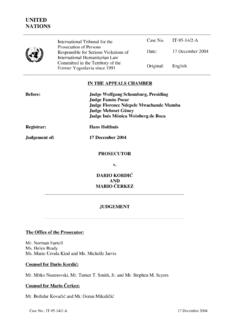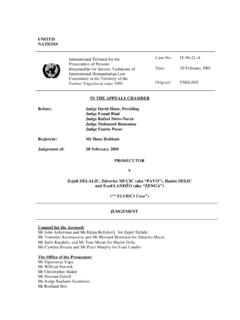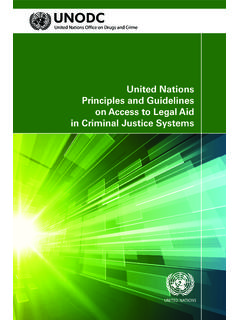Transcription of The International Criminal Court Reparations to …
1 The International Criminal Court Reparations to Victims of Crimes (Article 75 of the Rome Statute). and the Trust Fund (Aritcle 79). Recommendations for the Court Rules of Procedure and Evidence DINAH L. SHELTON. THORDIS INGADOTTIR. Prepared by the CENTER ON International COOPERATION. NEW YORK UNIVERSITY. for the 26 July 13 August 1999 Meeting of the Preparatory Commission for the International Criminal Court CONTENTS. FOREWORD. PROLOGUE. Reparations TO VICTIMS AT THE International Criminal Court . by Dinah L. Shelton I) INTRODUCTION. II) Reparations TO VICTIMS IN International LAW: SOME LESSONS FOR THE. International Criminal Court . 1. The Right to a Remedy 2. The Purpose of Remedies 3. Who May Claim Reparations 4.
2 Kinds of Remedies 5. Reparations in Large Numbers of Cases 6. Recommendations for the Processing of Claims under the Rome Statute III) CONCLUSIONS. THE TRUST FUND UNDER ARTICLE 79 OF THE ROME STATUTE. by Thordis Ingadottir I) INTRODUCTION. II) THE TRUST FUND. 1. The Trust Fund as "Depository" (art. ). 2. The Trust Fund as "Intermediary" (art. ). 3. Other Possible Sources of Funding for the Trust Fund ) The Court 's Budget ) Voluntary Contributions III) CONCLUSIONS. RECOMMENDATIONS TO THE PREPARATORY COMMISSION FOR THE International . Criminal Court . ANNEXES. I) Articles 75 and 79 of the Rome Statute II) Basic References (in chronological order). III) Authors' Biographies FOREWORD. The Center on International Cooperation is pleased to make available the following papers by Dinah Shelton and Thordis Ingadottir on "The International Criminal Court : Reparations to Victims of Crimes and the Trust Fund (Articles 75 and 79 of the Rome Statute)".
3 By doing so we hope to make a contribution to current discussions of the merits and means of victim Reparations under International law in the context of the July 26 August 13 meeting of Preparatory Commission for the International Criminal Court . The Center itself takes no position on the legal questions involved but believes that the views of the papers'. authors can help to both clarify provisions in the Rome Statute and inform decisions on the structure and use of the proposed Trust Fund. We invite readers to comment on the papers directly to the authors or to Center staff at The Center on International Cooperation is an independent institute, established at New York University in 1996, to conduct policy research and International consultations on the management and financing of multilateral commitments.
4 Our work, done in collaboration with partners around the globe, focuses on the institutions and actors that animate the International public sector and the body of norms, treaties, conventions and agreements that underlies it. In addition to maintaining a data-base on diverse areas of multilateral cooperation, we have undertaken specific projects on International justice, humanitarian assistance, post-conflict reconstruction aid and the Cairo Conference on Population and Development. Further detail on each of our projects is available, along with our publications and working papers, on the Center's web site < >. Aware that International law is the linchpin of this burgeoning International public sector the Center in partnership with the Foundation for International Environmental Law and Development launched the Project on International Courts and Tribunals.
5 The Project stems from an acknowledgment of the proliferation of International courts and tribunals and their increased use in virtually every areas of International activity. The Project's intent is to examine in a comprehensive and comparative framework -- the structure, function and use of these bodies, focusing particular attention on two interrelated matters: how institutional capacity and access affect the delivery of International justice. Additionally, the Project further seeks to clarify a number of legal issues that arise from the increased number and more frequent use of these International courts and dispute settlement bodies. The papers presented in this publication represent the Center's contribution to the goals of PICT and in no way are intended to imply an endorsement on the part of PICT, its co-sponsors at FIELD or the PICT.
6 Steering Committee. The Center is grateful to The Ford Foundation and the John T. and Catherine D. MacArthur Foundation for their generous support, to Sylvia Fernandez De Gurmendi and Hakan Friman for their advice on the choice of topic, to Dirk Solomons and David Donat-Cattin for providing helpful comments on drafts of these papers. Special thanks to Todd Diamond for his assistance in the final editing of this paper. Shepard Forman Director Center on International Cooperation PROLOGUE. The Statute of the International Criminal Court , adopted in Rome on 17 July 1998, is one of the most significant developments in International law and International relations of the second half of the twentieth century.
7 Regardless of whether and when it will enter into force, and how many States eventually accede to it, what has been accomplished in Rome cannot be cancelled and pushed into oblivion. It will always stand as evidence that impunity for war crimes, crimes against humanity, genocide and aggression is no longer acceptable at any place and at any time. Certainly, this is not the first time that humanity has taken such a firm stand. In the aftermath of the Second World War, the International Criminal Tribunal at Nuremberg and the International Military Tribunal for the Far East were established to try major German and Japanese war criminals. Again, at the beginning of the 1990s, atrocities committed in the Former Yugoslavia and Rwanda prompted the UN Security Council to establish two ad hoc International Criminal jurisdictions.
8 Yet, what makes the Statute of the International Criminal Court (the Rome Statute) significantly different from its predecessors, and in particular from the two more recent tribunals, is that for the very first time victims of crimes and their families can access the Court to express their views and concerns (Article 68. of the Rome Statute) and to claim reparation for the wrongs suffered (Article 75). Until the Rome Statute was adopted, the aim of International Criminal justice was essentially to help restore International peace and security by punishing those responsible for heinous crimes during war- time (retributive justice). The impartial trial and punishment of some criminals (and not always the most culpable ones) by itself was considered vindication.
9 Justice was done in the name of the abstract notion of "humanity" but not necessarily in that of the victims. In the Yugoslavia and Rwanda tribunals, victims can enter the courtroom only as witnesses, providing one of the means through which evidence may be brought before the tribunal. In the Rome Statute, however, those who have suffered have been elevated from a mere aid in the judicial process _ with no own interest to protect but that of the Criminal justice system _ into full legitimate participants. Several provisions in the Rome Statute stipulate the involvement of victims during all phases of the case ( Articles , , , 75, and ). Most importantly, victims of International crimes now can claim reparation for the violation of their rights.
10 They will do so on their own behalf or through their representatives, not through a State espousing their claims. The idea that individuals are entitled to have International judicial fora deciding upon and awarding Reparations is not new. First the European Court of Human Rights and then the Inter-American Court of Human Rights, have for decades been awarding victims Reparations . As the first part of this study shows, the individual's right to reparation is a fundamental human right that is not only expressly guaranteed by global and regional human rights instruments but also routinely applied by International and national courts. Yet, it is only with article 75 of the Rome Statute that the idea of restorative justice against the individual perpetrators of violations has become a dimension of International Criminal justice.








